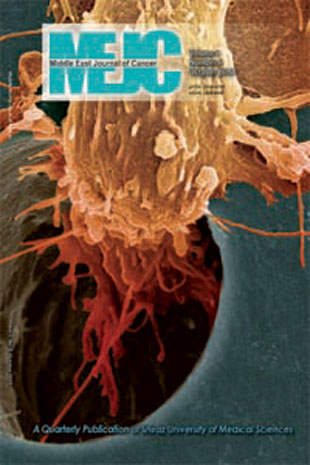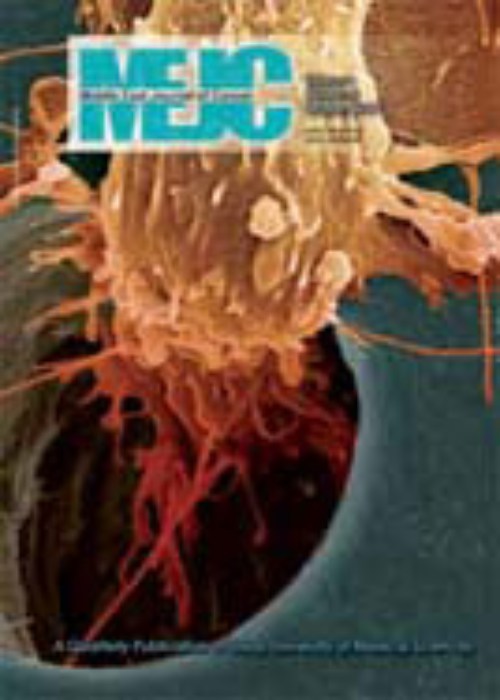فهرست مطالب

Middle East Journal of Cancer
Volume:3 Issue: 2, Apr & Jul 2012
- تاریخ انتشار: 1391/08/22
- تعداد عناوین: 9
-
-
Page 35BackgroundStudies about cancer-related trauma have shown that psychological reactions to the disease are not exclusively negative but most patients also report positive experiences. These positive perceptions are also called post-traumatic growth and benefit patients psychologically, spiritually, and physically. Therefore, we have conducted a study about how women with breast cancer perceive posttraumatic growth and the recognition of its dimensions in Iran.MethodsThis qualitative study was conducted by using Interpretative Phenomenological Analysis. A total of 23 women with breast cancer who met the inclusion criteria were selected after which patients completed a researcher-generated open-ended questionnaire. Data were analyzed according to the guidelines for the Interpretative Phenomenological Analysis and Smith method.ResultsParticipants’ perceptions in this study about post-traumatic growth included three themes: spiritual growth, appreciation of life, and increased personal strengths.ConclusionThemes found in this study conformed to dimensions according to the Tedeschi and Calhoun theory of post-traumatic growth. However, relations with others were not found in the present study. We propose that interventions should be designed and implemented in order to facilitate and enhance post-traumatic growth.Keywords: Breast neoplasm, Stress disorders, Traumatic, Post, traumatic growth, IPA
-
Page 45BackgroundThis prospective study assessed the efficacy of neoadjuvant and adjuvant chemotherapy on patients with high risk soft tissue sarcomasof the extremities.MethodsEnrolled patients received the following neoadjuvant chemotherapy: doxorubicin (75 mg/m2) on day1, ifosfamide (2.5 g/m2/d) and mesna (20% of the ifosfamide dose) from days1 to 3, repeated every three weeks for a total of three cycles, followed by surgery and radiotherapy. Patients received an additional three cycles of adjuvant chemotherapy that was the same as the neoadjuvant protocol following completion of radiotherapy.ResultsThere were 52 patients enrolled in the study, of which 50 were included in data analysis. Neoadjuvant chemotherapy was completed by 90% of enrolled patients and 88% completed all planned chemotherapy. A total of 96% of patients underwent surgery and 92% of these had R0 resections. Postoperative radiotherapy was administered to 96% of patients. The estimated three-year local-regional failure was 10%. Estimated three-year rate for distant disease-free survival was 66% and overall survival was 88%. One patient died with treatment secondary to leukopenic sepsis and respiratory failure. Grades 3-4 toxicities were experienced by 86% of patients of which 84% were grades 3- 4 hematologic toxicities and 38% were grades 3-4 nonhematologic toxicities.ConclusionThe current protocol is feasible and associated with favorable distant disease-free survival, overall survival, and limb preservation. This protocol is tolerable and has a manageable toxicity level.Keywords: Neo, adjuvant, Adjuvant chemotherapy toxicity, Survival, Soft tissue sarcomas
-
Page 55BackgroundThis study assesses the effect of oral cryotherapy on the incidence and severity of chemotherapy-induced oral mucositis in combined chemotherapy regimens.MethodsThis was a randomized controlled trial that enrolled 80 cancer patients. We evaluated the primary oral status of all patients prior to chemotherapy. Patients were divided into two groups, experimental and control. The experimental group was given ice to place in their mouths from 5 min before to 5 min after chemotherapy.The control group received no intervention. Both groups were treated with the following chemotherapy regimens: i) 5- fluorouracil + leucovorin; ii) cyclophosphamide + adriamycin + 5-fluorouracil; or iii) cyclophosphamide + methotrexate + fluorouracil. World Health Organization and patient-based oral mucositis scales were used for evaluation.ResultsAccording to the WHO based Oral Mucositis Scale, the incidence of oral mucositis in the intervention group (45%) was significantly lower than the control group (77.5%; P=0.01). The incidence of oral mucositis in the intervention group based on the Patient-Judged Oral Mucositis Scale was lower than the control group. The findings of this study indicated that patients who underwent cryotherapy had less severe oral mucositis based on both WHO (P=0.01) and patient oral mucositis scales (P=0.001).ConclusionOral cryotherapy because of its ease of application, tolerability and lack of side effects makes it an important resource for reducing the incidence and severity of oral mucositis. The role of oncology nurses is crucial to the application and success of oral cryotherapy.Keywords: Oral cryotherapy, Oral cooling, Mucositis, Stomatitis, Chemotherapy
-
Page 65BackgroundThis study determines the efficacy and tolerability of hypofractionated three-dimensional conformal radiotherapy in conjunction with daily temozolomide in treatment of previously irradiated recurrent malignant glioma.MethodsWe enrolled 21 patients diagnosed with recurrent or progressive malignant glioma who previously underwent external beam irradiation. All patients had hypofractionated three-dimensional conformal radiotherapy to a total dose of 30 Gy in six fractions, over a two-week period, concurrent with daily temozolomide (75 mg/m2).ResultsAt the median follow up of 9.5 months (range: 2.5-42), there were 18 (86%) patients who had died. Median overall survival from the onset of hypofractionated threedimensional conformal radiotherapy was nine months and median time to progression was five months. There was no detectable severe toxicity. Salvage surgery prior to hypofractionated three-dimensional conformal radiotherapy and planning target volume significantly influenced patient outcome according to multivariate analysis.ConclusionHypofractionated conformal re-irradiation concurrent with daily temozolomide is a feasible, well-tolerated treatment for recurrent malignant glioma. Patients with surgical re-resection and smaller planning target volumes have the most favorable outcomes.Keywords: Recurrent malignant glioma, Hypofractionated re, irradiation, Temozolomide
-
Page 75Plasmacytoma are extramedullary accumulations of plasma cells. Most extramedullary plasmacytomas are associated with the upper respiratory tract. The lung is rarely involved. We report a rare case of lung plasmacytoma with multiple myeloma. The patient is a 60-year-old male who presented with chest pain and a lung mass visualized on CT scan. A preliminary diagnosis of occult lung cancer with widespread skeletal metastasis was made. The diagnosis of lung plasmacytoma with multiple myeloma was made after extensive investigations.Keywords: Lung, Multiple myeloma, Plasmacytoma
-
Page 79The median overall survival in glioblastoma multiforme is usually less than one year. Long-term survival is rare and is seen in only 3%-6% of GBM patients. The present study reports the characteristics and treatment outcomes of six cases of glioblastoma multiforme with long-term survival. A literature review is also presented. Between 1990 and 2008, 217 glioblastoma multiforme patients have been treated at our center of which six cases (four males) survived for three years or longer. The mean age of the six cases was 25.7 years. All patients received postoperative radiotherapy with a mean dose of 55 gray and four patients received nitrosourea-based chemotherapy. Patients'' mean survival was 5.2 years. The results of this study and review of the literature have indicated that long-term (more than three years) survival is exceptional and mainly observed in younger patients with good performance status and following complete surgical tumor resection.Keywords: Glioblastoma multiforme, Long, term survival, Young age, Complete resection, Radiotherapy, Chemotherapy
-
Page 85BackgroundAccording to the literature, there are a number of chronic and acute myeloid leukemias with unique, complex chromosome translocations. This study aims to conduct a brief review of the incidence of complex chromosome translocations in myeloid leukemia and reports a case of myeloid leukemia with complex chromosome translocations.MethodsWe conducted a web-based search for all peer review articles published on the subject of complex chromosome tranlsocations in chronic and acute myeloid leukemia in MEDLINE, PubMed and Mitelman (http://cgapanci.nih.gov/ chromosomes/Mitelman) databases in addition to other pertinent web references. In addition, we performed conventional cytogenetic studies of 24- to 72-h cultures on bone marrow/peripheral blood cells obtained from the current case. Cells were finally treated by the giemsa-trypsin-giemsa banding technique.ResultsThe result of this case revealed an abnormal karyotype that had a novel complex translocation which involved chromosomes 2, 5, 9, and 22. We performed karyotyping after the initiation of chemotherapy. Karyotyping results showed a complex karyotype 46,XX,t(9;22;2;5).ConclusionThis study discusses a case of chronic myeloid leukemia with complex chromosome translocations and may provide novel information regarding these translocations in leukemias.Keywords: Complex, Chromosome, Translocation, CML, Leukemia
-
Page 89We report a case of multiple myeloma that presented with anorexia, fatigue, high erythrocyte sedimentation rate, bone marrow plasmacytosis of more than 30%, polyuria,and low urine specific gravity. This unusual presentation was diagnosed as nephrogenic diabetes insipidus secondary to a proximal tubular dysfunction. The tubular functional disturbance appeared to be related to the presence of lambda-type light chains. The patient was treated with desmopressine without response. After one month of treatment with thalidomide and dexamethasone for myeloma there was a dramatic response with decreased urine output.Keywords: Nephrogenic diabetes insipidus, Multiple myeloma, Lambda light chain, Amyloidosis


